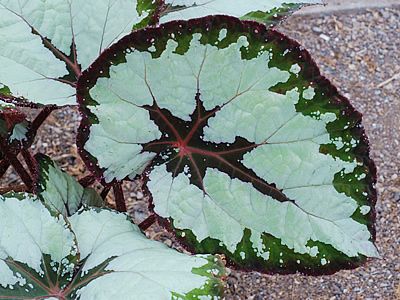The rex begonia (Begonia rex Cultorum Hybrids) is a herbaceous, evergreen, and rhizomatous plant native to forests and valleys with altitudes between 400 and 1,100 meters (1,312 – 3,609 feet) in China, India, and Vietnam. It has gained worldwide popularity due to the striking colors of its leaves. The rhizomes are broad and fleshy, and the leaves emerge directly from them with long, succulent, densely hirsute petioles. The leaves are characteristically asymmetrical, as well as ovate, alternate, and membranous, and can be entire, lobed, or incised.
They display very distinct colors in different patterns and shades, ranging from dark green with silver spots, to wine-red speckled with pink, and including lemon yellow and brown. There is an enormous variety of hybrids and cultivars. It blooms at any time of the year, producing white or pink flowers, depending on the variety, which are of little ornamental importance. The subsequent fruits are capsule-type.

Ideal for tropical climates, the rex begonia is a foliage of unparalleled beauty, not needing to bloom to cause awe. With its leaves intricately designed and painted by nature, we can add interest to unimaginable areas of the garden, where direct sunlight does not reach, such as in dense woods, for example.
The texture and colors of the rex begonia are also suitable for adding contrast with other species, or even with different varieties and cultivars of the same. Indoors, plant the rex begonia in beautiful Vietnamese pots, thus adorning office tables, sideboards, etc., or in winter gardens, serving as ground cover. Its exoticism will enchant onlookers.
It should be cultivated under diffuse light or bright shade, in humus-rich soil with good retention capacity, yet drainable. It appreciates tropical heat and humidity but rots quickly in stagnant and waterlogged conditions. Proper irrigation is the main secret of its cultivation. It’s important to use watering cans with long, thin spouts that reach the soil without wetting the leaves.
Similarly, one should avoid excessively hard, calcareous water, preferring well-rested water. Although suitable for interiors, good ventilation without excesses is essential. It fears intense cold or frosts, becoming annual in subtropical or temperate climates. In this case, it is advisable to cultivate it indoors or in protected greenhouses during the winter to maintain its beauty all year round. It can be easily propagated by leaf cuttings and plant division.


